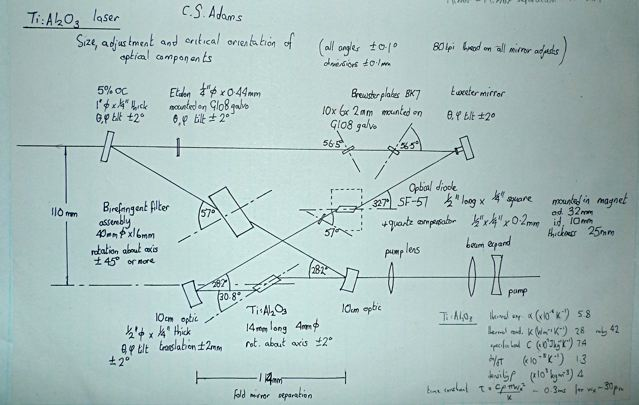Chapter 11
Chapter 11 Slides(pptx)
Errata
Last updated 2019-10-08
Exercises
- p. 193. Exercise (11.11). Mistake in formula for focal shift in part (c), it should be z_2 not z_R2.
Extras
Laser cavity design
Three decades ago I (CSA) began a PhD with the great Allister Ferguson. The goal would become to design and build the world’s first single-frequency Ti:sapphire laser. In January 1989 I began by designing a Nd:YAG ring laser. Below is a photograph of the first page of my PhD notebook.

To design a laser cavity, you start with the equations that describe the propagation of laser beams, and on the left (in the image) you can see a matrix equation that describes how the complex beam parameter q of a laser beam changes when it passes through a lens with focal length f (or is reflected by a curved mirror). I had learnt this equation from Geoff Brooker, except that his equation (see here) included an odd factor called “cancel me”. At the time I did not understand why I needed to “cancel me” but as long the equations gave the right answers (which they do) I could start building lasers. The Nd:YAG laser worked and we published a paper, then I started work on the Ti:sapphire laser. Using the same equations this is the desgin I came up with.

Using an early version of the laser we published a paper on Doppler-free spectroscopy of rubidium atoms. Later this laser was developed into a commercial product by Microlase (who subsequently became Coherent Scotland), and later still the laser was re-engineered by M2 laser into the award winning Solstice. Thousands of these lasers are in operation all over the world (about two thousand by now and counting). I mention this because it helps us to appreciate the utility of both maths and physics. Thirty years on, while writing a textbook on optics, I found the motivation to revisit those old equations on the complex beam parameter and rewrite them in a more elegant form. As I suspected there is no need for “cancel me” or even to write the equation in the form of a matrix times a vector. The point is that a gaussian beam is simply a paraxial spherical wave with a complex argument (see p. 178 in Optics f2f) and an ideal lens or curved mirror is simply an element which modifies the curvature of a spherical wave (see p. 27-8 of Optics f2f). This beautiful piece of mathematics (p. 181 in Optics f2f), with real applications, has been putting `bread on the table’ for many, for many years.
